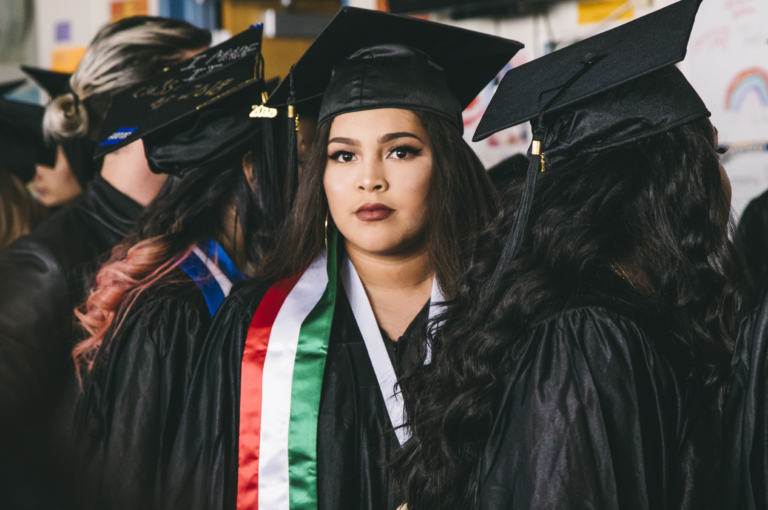A cross post from Carrie Chan and the Ed78 crew
In the last CRUNCHED! blog post, I looked at citywide graduation rates (takeaway: steadily improving year-over-year in Oakland, but gaps persist). As our recent grads start thinking about post-grad life, I wondered from a data perspective how to dig deeper into the question around whether students are prepared for life after high school. (Being “ready” can mean different things to different people; I’m not sure I felt fully prepared, or maybe no one ever really does.) But using what limited data is available, I asked the question: Are Oakland public high school grads getting the coursework that, according to the State of California, means they’re really academically ready for college and future careers?
Are Oakland’s students ready for success post-high school?
The goal of high schools should not only be to help their students graduate, but also to ensure that they’re ready for the post-high school world ahead of them. Focusing on 4-year cohort graduation rate as the sole measure of progress is not enough; a diploma alone no longer equals success in this modern post-high school world . One longtime proxy measure of this readiness has been to look at how many students are A-G ready, which means they’ve completed coursework that meets basic admission requirements for UC/CSUs, our two state university systems. By this traditional measure, almost half of the students in Oakland are prepared for college because they’ve taken and passed the coursework leading up to it.

Figure 1. Graph showing Oakland citywide (including charter and district high schools) 4-year cohort graduation outcomes for 2017-18.
Acknowledging that not all post-high school paths lead to 4-year colleges and that coursework alone is not enough to be prepared, the California Department of Education (CDE) included this past fall a College/Career Indicator (CCI), which has multiple pathways to gauge academic preparedness for post-high school life. Some pathways are more aligned for college and others more aligned for a career. Innovate Public Schools published an awesome, parent-friendly explainer on CCI that I highly recommend checking out.

Figure 2. Bar graph comparing different subgroup rates of 4-year cohort college/career readiness as defined by College/Career Preparedness Indicator from CA School Dashboard
Under this new metric, which now has a broader set of criteria to define preparedness, only 38% of the 4-year cohort are considered prepared for college/career post-grad pathways. 18% are approaching the level that would consider them prepared, while 42% are not prepared for college and/or career. The differences vary sharply across ethnicities, with Latinx and Black students (the two largest racial groups in Oakland) facing wildly different odds than Asian and White students. The data finds that an Asian student is more than 2X more likely to be prepared for college/career than a Black student.
Two reasons I’m hopeful:
1. Local bright spots. Focusing on how individual Oakland high schools prepare grads of color for post-HS life, there are schools with positive progress. 64% of COVA High’s African American students and 95% of CCPA’s majority Latinx grads (the highest percentage by far in the entire city!!!) were considered prepared on the Dashboard College/Career indicator in 2018.
2. A village coming together to support our kids. We hear stories of students not adjusting to college well, and those adjustments are hardest to make for those who are low-income and first in their family to pursue higher education. Anecdotally, I’ll offer my own experience: I was one of those students and who was NOT prepared for the socioemotional challenges in college and struggled throughout those years, especially with balancing familial obligations that so many low-income students shoulder starting early in their lives. It excites me to see a mighty “village” coming together to support our Oakland grads. Organization like Oakland Promise are scaling up their financial assistance programs (through financial aid navigation support in their future centers and $8.5M in scholarships) to help lower barriers to get into college, while organizations like East Bay College Fund and Beyond12 are going beyond K-12 by mentoring and supporting students while they’re in college.
So what’s next?
Even if a student gets into college or a career path, there’s currently no way to track whether they’re persisting and completing post high school programs or not. Currently, the general public doesn’t have much insight into the future of students after high school. The data nerd in me would love to see implementation of a longitudinal data system to track which students are persisting and actually succeeding, matching those figures with the numbers predicted by the College/Career Indicator. (Fingers crossed for bills for longitudinal data systems currently making their way through legislature!)
At the state level, the CDE has signaled clearly that simply graduating is not enough to be prepared in the 21st century. Though Oakland has improved overall graduations rates over the past few years, progress still needs to be made as only a little over half of the city’s graduates are ready for college and the work world—especially if we are to do right by our historically underserved students and ending cycles of lower educational preparedness.

